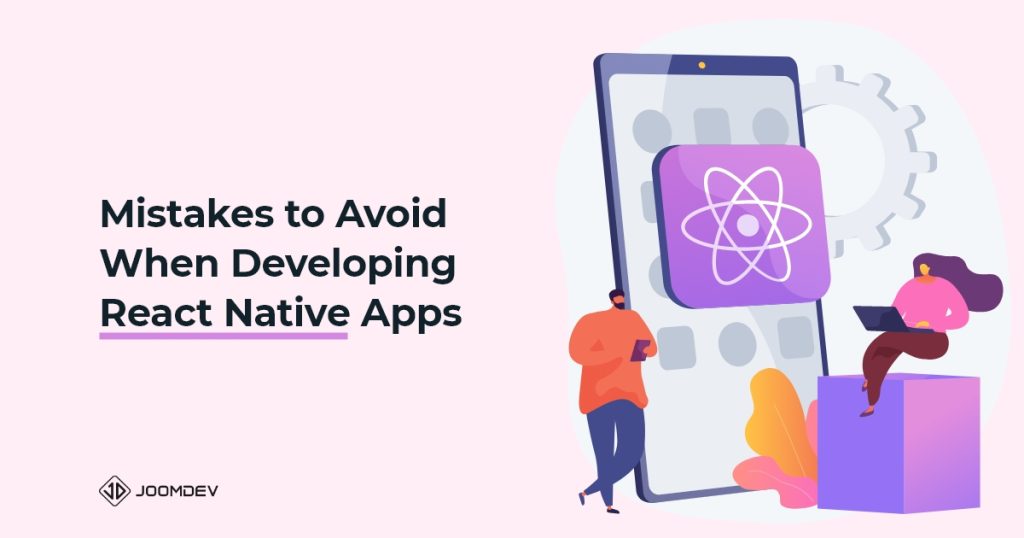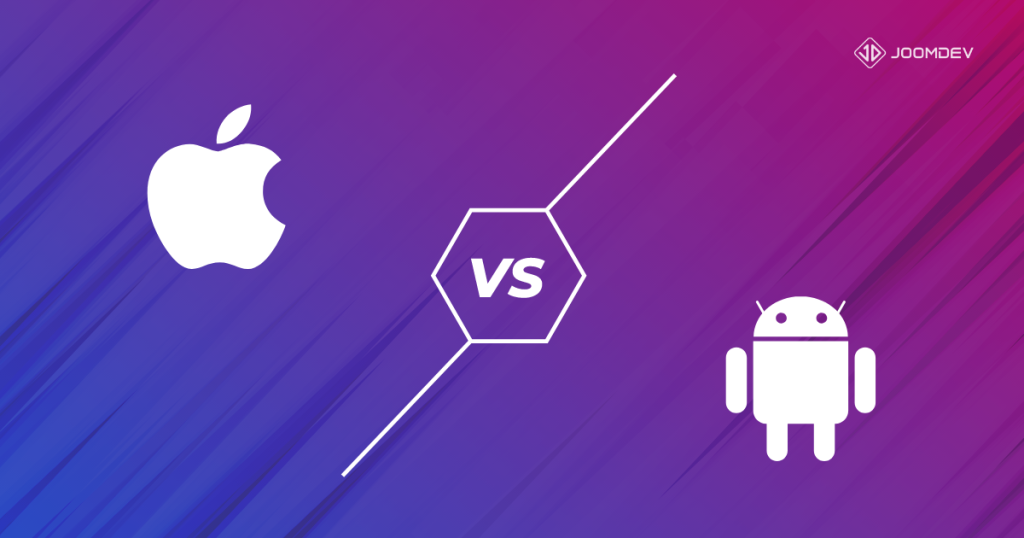React Native is widely used for building mobile apps. Some people like React Native as an app development framework because it lets them get their apps running on several different platforms like Android, iOS, and Windows. Others are happier for a different reason—it makes their jobs easier.
Be it an entrepreneur or a developer, everyone appreciates it because of the advantages it provides!
Moreover, there has been a constant battle between Android vs iOS – which platform should businesses choose. That is why developers from all over the world use React Native to make cross-platform mobile apps that work well on both iOS and Android.
This framework is also gaining popularity because of its easy workflow. But before you opt for React Native app development, there are some things that you should consider.
Unfortunately, React Native app development is rife with common mistakes that can prove fatal for your business. But this doesn’t have to be the case. With awareness of rookie mistakes, you can harvest the riches of the framework and reap high returns on your investment in this technology.
In this blog post, we will discuss the mistakes you should avoid while developing a React Native app. We’ll also look at the effects of these mistakes on your app.
So, without further ado, let’s dig into the details.
But before proceeding further, let’s know the reasons why developers love developing React Native apps.
Mistakes to Avoid When Developing React Native Apps
Why do developers love developing React Native apps?
The demand for react native apps has grown over the years. Here are the reasons why:
Use of JavaScript
JavaScript is a programming language commonly used to create dynamic and interactive web pages. Many developers start their careers with JavaScript and thus have a good understanding of the subject matter. React Native relies entirely on JavaScript, bringing down the learning curve greatly.
As time passes, other programming languages will compete for market share, but JavaScript’s influence will remain. That is why it will be a good idea if you already know about the best IDEs for modern JavaScript developers.
Build Native Applications
Even though the developers who write React Native code don’t use web technology, they can still make use of native-looking platform conventions on the web, such as activity indicators, to give users the impression that they are using native applications. While it is possible for a cross-platform developer to build native applications, the user experience may suffer.
Easy Installation Process
You install React Native through the Node Package Manager, which is extremely easy for developers with a JavaScript background to use. Even if you lack an understanding of JavaScript, React Native will prevent you from the hassle of downloading a binary from the source.
Greater Productivity
One way to build apps faster is to increase developer productivity. And a JavaScript-based language with reliable code compilation makes it easier than ever to do so. This language includes a live reload feature, allowing you to see changes in real-time as well as the option to use any IDE or text editor of your choosing.
Strong Community Backing
React Native has become extremely popular in recent years. Developers and businesses in a variety of industries and backgrounds have adopted it because of the many benefits it offers. This has created a strong, widespread community that is constantly making adjustments to React Native’s pros and cons on a daily basis.
Cross-platform Framework
React Native is a cross-platform framework, meaning it can be used to code mobile apps that work across devices, including smart TVs, smartwatches, Windows devices, and VR headsets. To overcome the challenges of ReactJS, wherever you may be located, it is advisable to hire a ReactJS Development Company to build and develop custom ReactJS apps according to the latest features.
The challenges of building React Native apps
Even though react native applications holds great potential, developers face certain challenges while building react native apps. Let’s take a look at them:
Dependency on Native app developers
JavaScript programmers sometimes have to rely on native developers to help them perform complex computations. When apps must handle heavy computational loads, native developers can help JavaScript programmers offload some of the processing to the native part of the app.
Limitations in Abstraction Layer
In order to add more functionality to React Native apps, people often develop an abstraction layer. The abstraction layer itself comes with its own persistent issues. Here are the following:
- High reliance on third-party services and libraries
- Implementation of custom designs is essential
Zero Support for Parallel Threading
One major React Native limitation is that it only has a single Javascript thread, which slows down the execution speed of any operations that can be performed in parallel.
iOS Deployment is particularly difficult
Developers have found that testing their React Native apps for iOS on services other than Apple’s Testflight is particularly troublesome since issues arise with getting the necessary provisioning profiles and certificates. However, this is not the exact scenario for the Android platform. React native apps run very smoothly on Android devices.
While React Native is a great framework for app development, there are still challenges that come with using it. If you’re unfamiliar with it or any other framework, then you could run into problems. And that is why as a skilled React Native developer, it is important to be aware of the mistakes that can happen while building React Native applications.
So, let’s get to know about the mistakes so that you can build an error-free react native app.
Mistakes to Avoid When Developing React Native Apps
If your development team is prone to making mistakes, you won’t be able to use React Native. Let’s discuss some of the most common mistakes developers make using React Native and see how to avoid them moving forward.
Disproportionate Image Optimization
When it comes to app development, image optimization is one of the most important processes. But sometimes app development teams are too busy coding to make sure that they don’t forget to optimize their images. When they do, they run the risk of having their apps released with images that aren’t aligned properly.
Optimizing images for faster loading speeds is one of the easiest ways to make your website or app work more efficiently. Moreover, image optimization also allows you to resize images locally, then upload them quickly to cloud-based storage like Dropbox or Google Drive.
Proper image optimization means that your app is faster and more scalable, so don’t make this mistake if you want to develop a full-fledged app.
Misaligned redux store planning
When you plan the redux store of a new project, you have to focus on more innovative ideas—not just the layout. If you don’t, you are going to make mistakes. The correct redux store planning will help you to manage and store your data correctly. And it will also help you to debug your app rate and fix your data, too. So if you get it wrong, then that’s the end for you.
Moreover, if you have a small project, you can keep your code clean and readable by avoiding redux store planning. Follow these steps to avoid this React Native app development mistake:
- Configure the store
- Keep your files organized by building a store hierarchy
- Focus on combining reducers and adding more reducers
- Consider adding middleware
- Apps that use React Native Databases
Not giving enough attention to details
When it comes to React Native, one of the biggest mistakes Newbies do is an underestimation of estimating the project hours. Yes, there are a number of reusable components available for React Native developers, but both iOS and Android have different layouts and the structure of the page may be completely different from platform to platform. Thus, you need to be super careful or you may end up losing more than what you’ve expected.
Moreover, while using external modules to save time, always make sure that you understand the code written in them. This will help avoid errors that can occur while using the module. If you want your app to be successful, avoid the mistake of adding external modules that can interfere with the existing codes and hamper its functionality.
Usage of stateless components
As the saying goes, “Change is the only constant in life,” and that’s certainly true for React as well. While it’s tempting to think that everything that was true about React before React 16 still holds true now, that’s not the case. As a result, developers who initiate the stay in the wrong way are likely to be confused by how state and component lifecycle methods work in React 16.
React Native allows for the creation of components that do not extend any class. These are known as stateless components, and without them, pure components cannot be used. You could also perform any DOM function by sending an AJAX request inside componentDidMount.
Avoiding writing a Unit Test
Developing a React Native application with implicit unit tests can be a very big mistake. Having no documentation of your development efforts can leave you in trouble because to fix any errors you will need to put in a lot of effort. Should you choose not to fix the product, then end-users will see bugs every time they use your app.
Write unit tests in order to reduce drama related to the launch of your apps. This will increase the reputation of your apps as well as make sure that your app is developed in a hassle-free manner. Write unit tests for every part of your app so that developers can work separately on different parts without any issues. Additionally, writing unit tests can save developers from undue stress by verifying that their code works as intended. It can also help them find bugs early in the process before they create larger problems and bugs.
Left ‘console.org’
Try to avoid logging application-specific messages in your console output. Although this practice is helpful during debugging, if you are logging unsynchronized messages, you might cause problems.
When a React Native app is unsynchronized, there is congestion in the JavaScript thread. All this congestion will add up, and eventually slow down the pace of the appliance. Thus, developers should use the log statements wisely. They should not leave the log statements in the application.
Changes in the state inside the render function
The View is the presentation of data supplied by the Datastore. The View depends on time and only stores what the user needs to see at a given time. The Data Store also depends on time, but it also stores extra information for use in future data displays. When the Data Store needs to supply information to the View, it reads from the Datastore.
React Native offers setState(), which creates a new state object based on the previous state, then merges it with your update. This new state object is added to the store, and the app will use it from now on. This cycle runs throughout the life of a component, provided you’re developing in React Native.
However, by changing the state directly, you disrupt the lifecycle of the component. This may cause abnormal behavior in the application and can even cause it to crash.
Furthermore, if you are a developer working with React Native, there is a chance that you will lose track of previous states. This will lead to the creation of custom code in place of React, and since these custom codes are written to maintain state changes, your app will get heavier and the loading time will increase.
Not paying heed to protocols
When developing for React Native, it’s important to adhere to proper coding standards, since deviating from them can leave your app in a bad situation. Numerous best practices exist, such as following naming conventions to increase readability.
Also, if you don’t stick to the standard protocols, your development process will not be successful. So, to be sure that you are developing in the right way, always follow standard protocols.
Ignoring the project structure
It is well known that complex applications require a clear and well-defined structure. A mistake in the structure can lead to confusion and make it difficult to maintain the project. Thus, developers should take care to structure the project in such a way that the different elements can be easily accessed and modified.
If developers and designers can rely on an organized project directory, they will have an easier time collaborating on React Native projects. If the people working on a project can find the files they need quickly, everyone will benefit in the long run. For this reason, you need to have a good, comprehensive project structure. With React Native development, developers can have the benefit of incorporating good project structures.
React Native App Development: How to Avoid Mistakes?
Firstly, everyone makes mistakes, even skilled developers having 10-15 years of experience. Developing a zero percent error-free React Native app should not be your goal. Instead, you should try not to commit mistakes that are mentioned in this blog post or the mistakes that are recommended by mobile app developers in general.
So, in order to avoid React Native app development mistakes, you can follow either of the two paths:
Stay on top of your game by upgrading your skills
Starting your career with courses gives you a good start when you are just beginning. However, staying up to date can benefit you greatly, even when you have years of experience. When working on many projects, it’s nice to go back to the basics and relearn things from scratch.
And remember, there is always room for improvement! So, keep your game up and brush up on your skills by enrolling in related courses.
Join a React Native App Development Company
If you are a beginner, then we suggest you join a mid-sized React-Native app development company. By doing so, you will be having practical exposure to building native apps. Moreover, such companies have access to the latest tools and technologies, thereby giving you full exposure to modern technologies.
But remember when looking for joining a company, always opt for mid-sized companies, not small or large companies. That is because of the time and opportunities they have for the newbies.
On the contrary, if you are looking for outsourcing mobile app development services for your company, then you should read this article, 9 Reasons Why Outsourcing Mobile App Development Services is Key in 2022.
Wrapping-Up
React Native app development offers everything you need to build the best app for your business, but it will take hard work to get there. There are unhealthy practices that can lead to poor results, and there are common mistakes that can bring progress to a halt.
Moreover, it is always a good idea to hire a top-notch react native app development company that will guide you throughout the process and help you in building an app for your business at the same time.
I hope this article helped you identify the common mistakes that are made when developing native apps for React.
If you have any doubts or questions, feel free to ask in the comments section. We will be happy to answer your questions!

Want to develop a mobile app for your startup that run on all the platforms?
Don’t worry, we are here to help you. Let’s book a free consultation call with our expert and let us understand your business and what you want to achieve.
We strategize, design, develop and help your business idea to turn into reality and make it successful.







